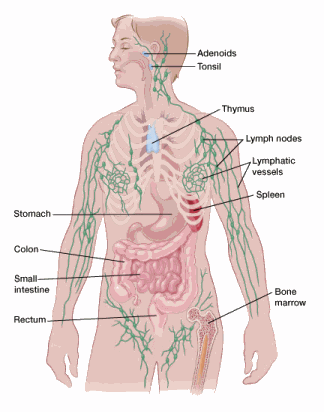Your gift is 100% tax deductible
What Is Non-Hodgkin Lymphoma in Children?
Cancer starts when cells in the body begin to grow out of control. Cells in nearly any part of the body can become cancer, and can then spread to other areas of the body. To learn more about cancer and how it starts and spreads, see What Is Cancer?
The types of cancers that develop in children are often different from the types that develop in adults. To learn more, see Childhood Cancer.
Lymphoma is a type of cancer that starts in cells called lymphocytes, which are part of the body’s immune system.
Hodgkin and non-Hodgkin lymphoma
The main kinds of lymphomas are:
- Hodgkin lymphoma (HL), also known as Hodgkin disease, which is named after Dr. Thomas Hodgkin, who first described it
- Non-Hodgkin lymphoma (NHL)
These lymphomas differ in how they behave, spread, and respond to treatment, so knowing which type your child has is important.
Both of these types are more common in adults, but they can also develop in children and teens. Younger children are more likely to have NHL, while Hodgkin lymphoma is more likely to affect older children and teens.
Different types of NHL can develop in children and teens. Treatment depends on which type of NHL it is, so determining the exact type a child or teen has is important.
Hodgkin lymphoma is treated similarly in children and adults. For more information on this disease, see Hodgkin Lymphoma.
The lymph (lymphatic) system
The cells in which lymphoma starts (lymphocytes) can be found throughout the body’s lymph system, so knowing about the lymph system can be helpful in understanding lymphoma.
The lymph system is part of the body’s immune system, which helps fight infections and some other diseases. It also helps fluids move around in the body.
Lymphocytes
The lymph system is made up mainly of lymphocytes, a type of white blood cell. The main types of lymphocytes are:
- B lymphocytes (B cells): B cells normally help protect the body against germs (bacteria or viruses) by making proteins called antibodies. The antibodies attach to the germs, marking them for destruction by other parts of the immune system.
- T lymphocytes (T cells): There are several types of T cells, each with a special job. Some T cells destroy germs or abnormal cells in the body. Some T cells help boost or slow the activity of other immune system cells.
Lymphomas can develop from either B cells or T cells.
Parts of the lymph system
The lymph system is in many parts of the body, so lymphomas can start almost anywhere. (This can affect what symptoms a child has.)

Lymph tissue is found in:
Lymph nodes: Lymph nodes are bean-sized collections of lymphocytes and other immune cells throughout the body. They can sometimes be felt under the skin in the neck, under the arms, and in the groin. Lymph nodes are connected to each other by a system of lymphatic vessels.
Lymph nodes get bigger when they fight infection. Lymph nodes that grow because of infection are called reactive nodes or hyperplastic nodes and are often painful when they are touched. An enlarged lymph node in a child or teen is most often a reactive node. For example, lymph nodes in the neck are often enlarged in children with sore throats or colds. But a large lymph node is also the most common sign of lymphoma. This is covered in more detail in Signs and Symptoms of Non-Hodgkin Lymphoma in Children.
Spleen: The spleen is an organ behind the lower ribs on the left side of the body. The spleen makes lymphocytes and other immune system cells. It also stores healthy blood cells and filters out damaged blood cells, bacteria, and cell waste.
Bone marrow: The bone marrow is the spongy tissue inside certain bones, which is where new blood cells (including some lymphocytes) are made.
Thymus: The thymus is a small organ behind the upper part of the breast bone and in front of the heart. It's important in the development of T lymphocytes.
Adenoids and tonsils: These are collections of lymph tissue in the back of the throat. They help make antibodies against germs that are breathed in or swallowed. They are easy to see when they become enlarged during an infection, which occurs often in children.
Digestive tract: Lymph tissue is also scattered throughout the stomach and intestines, and is in many other organs as well.
- Written by
- References

The American Cancer Society medical and editorial content team
Our team is made up of doctors and oncology certified nurses with deep knowledge of cancer care as well as editors and translators with extensive experience in medical writing.
Gross TG, Kamdar KY, Bollard CM. Chapter 19: Malignant Non–Hodgkin Lymphomas in Children. In: Blaney SM, Adamson PC, Helman LJ, eds. Pizzo and Poplack’s Principles and Practice of Pediatric Oncology. 8th ed. Philadelphia Pa: Lippincott Williams & Wilkins; 2021.
National Cancer Institute Physician Data Query (PDQ). Childhood Non-Hodgkin Lymphoma Treatment. 2016. Accessed at https://www.cancer.gov/types/lymphoma/patient/child-nhl-treatment-pdq on May 5, 2021.
Termuhlen AM, Gross TG. Overview of non-Hodgkin lymphoma in children and adolescents. UpToDate. 2021. Accessed at https://www.uptodate.com/contents/overview-of-non-hodgkin-lymphoma-in-children-and-adolescents on May 5, 2021.
Last Revised: August 10, 2021
American Cancer Society medical information is copyrighted material. For reprint requests, please see our Content Usage Policy.
American Cancer Society Emails
Sign up to stay up-to-date with news, valuable information, and ways to get involved with the American Cancer Society.



